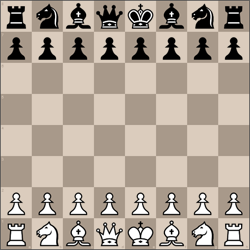< Prev Index Next >
 Chess 15 Mar 1918, Fri The Salt Lake Tribune (Salt Lake City, Utah) Newspapers.com
Chess 15 Mar 1918, Fri The Salt Lake Tribune (Salt Lake City, Utah) Newspapers.com
(a) The usual move is P-B3 and the Handbuch gives as a reply 4. … BxN saying 4. … N-QB3, is followed by 5. Q-N3 Q-Q2; 6. BxPch QxB; 7. QxP, overlooking that this is only a draw after 7. … K-Q2; 8. QxR BxN; 9. PxB QxBP; 10. R-N1 QxKPch. Black may also reply to 4. P-B3 with either P-QB3 or N-Q2.
(b) P-B3 could not be played, so as to preserve the king's bishop.
(c) B-N3 or B-N5ch could be played, but there is nothing wrong with White's maneuver of playing so as to take with knight, only this knight should have been brought to K3 later.
(d) B-N5 followed by N-K3, was now in order.
(e) Unnecessary and creating a weakness on the king's side, which Black soon makes use of.
(f) Rather Q-K3.
(g) After this White cannot save the game. He probably overlooked Black's 23rd and thought he would get enough for his queen. K-R2 should have been played. Then 17. … BxR; 18. NxB R-B5 would have left the material even. Black having the advantage in position.
(h) Perhaps White on his 20th turn, in preferring Q-K2 to Q-K3, thought he could here play K-B3. But then 22. … Q-R6ch; 23. K-K4 Q-B4ch; 24. K-Q5 P-B3ch; 25. KxP P-K5, and mate could not long be averted.
(i) The simplest way to win.
Mor Weiss Testa (white) vs. Stasch Mlotkowski (black)
Philidor Defense
Submitted to chessgames.com on 05/03/2025























